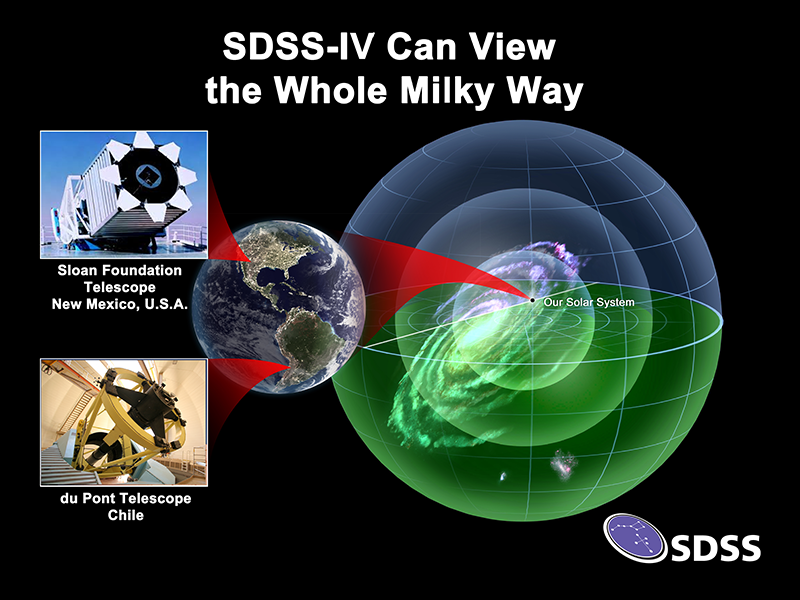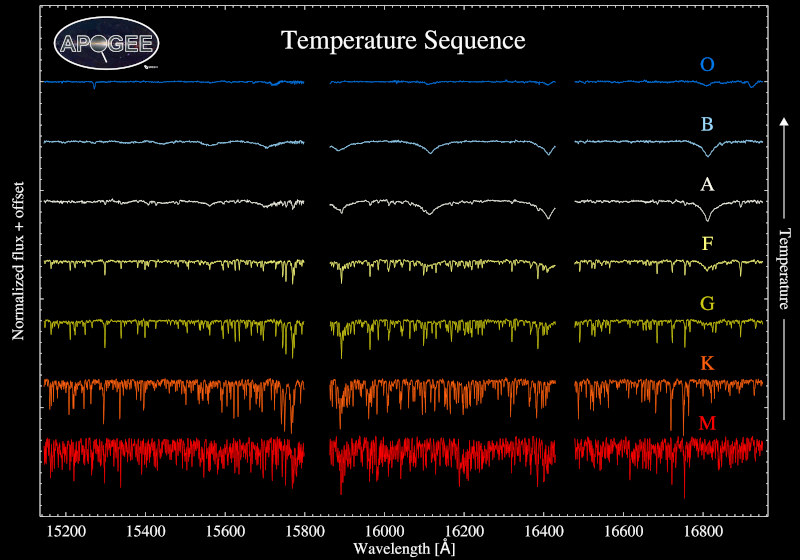On December 6th 2021, scientists from the Sloan Digital Sky Survey (SDSS) released the largest-ever detailed census of stars in our own Milky Way galaxy, with the complete release of data from its Apache Point Observatory Galactic Evolution Experiment (APOGEE).
The colors in the spectra show dips, the size of which reveal the amount of these elements in the atmosphere of a star. The human body on the left uses the same color coding to evoke the important role these elements play in different parts of our bodies, from oxygen in our lungs to phosphorous in our bones (although in reality all elements are found all across the body).
In the background is an artist’s impression of the Galaxy, with cyan dots to show the APOGEE measurements of the oxygen abundance in different stars; brighter dots indicate higher oxygen abundance.
Click to download a larger version from Google Drive.
Image credit: Dana Berry/SkyWorks Digital Inc.; SDSS collaboration
“For the last decade we have been working to map the Milky Way, and measure extremely detailed properties of the stars within it,” said Steven Majewski of the University of Virginia, who has been PI of APOGEE since 2006. “Seeing this phase of SDSS come to a close is extremely gratifying, especially considering that we ultimately gathered data on more than ten times as many stars as we originally planned.”
APOGEE works by measuring spectra, a kind of detailed rainbow, of stars in the infrared part of the spectrum. By working in infrared light, the award-winning APOGEE instruments can peer through the thick clouds of dust that obscure the inner Milky Way to get a more complete view of our own Galaxy.
The APOGEE experiment has measured more than two million spectra of nearly 700,000 individual stars, making it the largest high-resolution, near-infrared spectroscopic sample of stars ever observed. As with all prior projects from the SDSS, the full dataset is now online for anyone to use.
Astronomers can read each of these stellar spectra like a barcode, revealing which elements are present in the star. The elements that we can detect with APOGEE include carbon, nitrogen, oxygen, and iron — in fact, APOGEE researchers have used the spectra to map the elements that compose over 97 percent of the human body.
APOGEE Science Working Group Chair, Rachael Beaton explains, “By carefully studying how much of each of these elements we see in each star, we can piece together each star’s location in the Milky Way’s disk, bulge, or halo — and also how old each star is.”
APOGEE is not only the largest survey of its kind, it also has a special two-hemisphere view of the Milky Way. Making use of two identical instruments – one at Apache Point Observatory in New Mexico, and the other at Las Campanas Observatory in Chile — allows SDSS scientists to map stars in all parts of the Milky Way in a uniform way.
SDSS-IV will extend its reach by using both the Sloan Foundation Telescope at Apache Point Observatory and the du Pont telescope at Las Campanas Observatory in Chile, as shown to the left of the globe.
Because of the orientation of the Earth’s axis relative to the disk of the Milky Way, the northern telescope will observe a very different part of the Milky Way (shaded in blue) than the southern telescope (shaded in green), which will have an excellent view of the galactic center regions. The nested spheres show the range of distances from the Sun that the survey of the Milky Way will reach, depending on survey strategy and the density of stars and dust along the line-of-sight. Some observations will reach to the innermost sphere, while the deepest observations will extend to the outermost sphere and our neighboring dwarf galaxies, the Magellanic Clouds, shown at the bottom of the image.
Click to download a larger version from Google Drive.
Image credit: Dana Berry / SkyWorks Digital, Inc. and the SDSS collaboration
“Having identical instruments in the North and South allowed us to map all parts of our Milky Way galaxy”, says Beaton. “The center of the Milky Way, and its neighbors the Large and Small Magellanic Clouds, can only be seen from the Southern Hemisphere, while from the Northern Hemisphere we see the outer parts of the galaxy”.
This unique, dual hemisphere view has enabled many different kinds of science results from APOGEE. For example, APOGEE results have picked apart stars in the Milky Way into two chemically distinct populations based on where and how they formed. The chemical makeup of stars reveals what kinds of interstellar clouds they formed from, and how those interstellar clouds in turn became enriched chemically by previous generations of stars. One of the groups of Milky Way stars shows evidence of having formed out of clouds enriched by lots of rapid star formation relatively early on in the life of the Galaxy. This group is more vertically extended than the other population, which formed out of clouds enriched by more gentle star formation.
Other results from APOGEE reveal how stars move around in the Milky Way, or pick out stars which joined our galaxy in special events when smaller galaxies were eaten by our large home galaxy. APOGEE spectra have also been used to reveal new information about how stars themselves work: for example with new measurements of what fraction of stars are found in binary or triple systems, or the discovery of interesting rare objects.
Another unanticipated result from APOGEE was that its large database of stars, combined with advances in stellar astrophysics from the Kepler Space Telescope, have allowed astronomers to discover a new tool to find the ages of stars. Using new techniques like this, APOGEE scientists have made major advances in identifying sets of stars with nearly-identical chemical patterns across the Milky Way, helping to reveal the history of our galaxy’s formation and evolution.
Click to download a larger version from Google Drive.
Image credit: Steven Majewski and the SDSS collaboration
Mike Blanton, Director of SDSS-IV reflects, “When APOGEE began ten years ago, we knew it would give us a unique view of the history of the Milky Way, but we didn’t know we’d be able to expand it to Las Campanas to see its inner parts, and we didn’t know that so much detail of its history our scientists would be able to untangle. I’m looking forward to what other surprises the astronomical community will find in the data now that all of it is public for anyone to use, and to the new discoveries which will come from the SDSS-V Milky Way Mapper program.”
Contacts
- Steven Majewski, University of Virginia, +1-434-924-4893, srm4n@virginia.edu
- Rachael Beaton, Princeton University, +1-434-760-1404, rbeaton@princeton.edu
- Karen Masters, SDSS-IV Spokesperson, Haverford College, 610-795-6066, klmasters@haverford.edu
Twitter: @KarenLMasters / @SDSSurveys - Jordan Raddick, SDSS-IV Press Officer, Johns Hopkins University, 443-570-7105, raddick@jhu.edu
Press Releases
All prior SDSS press releases can be found in the press release archives of the various phases of the SDSS:
SDSS-IV Press Release archive
SDSS-III Press Release archive
SDSS-I/-II Press Release archive
About the Sloan Digital Sky Survey
Funding for the Sloan Digital Sky Survey IV has been provided by the Alfred P. Sloan Foundation, the U.S. Department of Energy Office of Science, and the Participating Institutions. SDSS acknowledges support and resources from the Center for High-Performance Computing at the University of Utah.
Funding for the Sloan Digital Sky Survey IV has been provided by the Alfred P. Sloan Foundation, the U.S. Department of Energy Office of Science, and the Participating Institutions. SDSS acknowledges support and resources from the Center for High-Performance Computing at the University of Utah. The SDSS web site is www.sdss.org.
SDSS is managed by the Astrophysical Research Consortium for the Participating Institutions of the SDSS Collaboration including the Brazilian Participation Group, the Carnegie Institution for Science, Carnegie Mellon University, Center for Astrophysics | Harvard & Smithsonian (CfA), the Chilean Participation Group, the French Participation Group, Instituto de Astrofísica de Canarias, The Johns Hopkins University, Kavli Institute for the Physics and Mathematics of the Universe (IPMU) / University of Tokyo, the Korean Participation Group, Lawrence Berkeley National Laboratory, Leibniz Institut für Astrophysik Potsdam (AIP), Max-Planck-Institut für Astronomie (MPIA Heidelberg), Max-Planck-Institut für Astrophysik (MPA Garching), Max-Planck-Institut für Extraterrestrische Physik (MPE), National Astronomical Observatories of China, New Mexico State University, New York University, University of Notre Dame, Observatório Nacional / MCTI, The Ohio State University, Pennsylvania State University, Shanghai Astronomical Observatory, United Kingdom Participation Group, Universidad Nacional Autónoma de México, University of Arizona, University of Colorado Boulder, University of Oxford, University of Portsmouth, University of Utah, University of Virginia, University of Washington, University of Wisconsin, Vanderbilt University, and Yale University.






